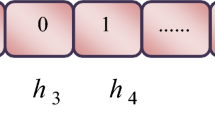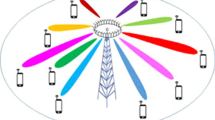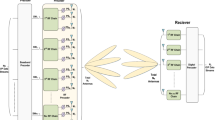Abstract
Massive multi-user multiple input multiple output is a very promising technique for next generation communication. It can provide further improvement to the wireless communication link performance due to relatively large number of transmitting antennas equipped at the base station. This large number has the potential to improve the performance but these systems suffer from high cost, complexity and large size. The transmit antenna selection (TAS) can be employed to solve these problems and with the objective of maximizing the achievable ergodic capacity. In this paper, The TAS problem is solved using a modified evolutionary algorithm, in particular, the chaotic binary particle swarm optimization algorithm is utilized for maximization of the total achievable capacities with reduced system complexity and minimized hardware cost. The multi-user is supported using the zero-forcing baseband beamforming. The convergence of the proposed evolutionary algorithm is proved and its performance is evaluated using numerical analysis. The presented results proved that the proposed evolutionary algorithm can achieve competitive ergodic capacities while utilizing small number of radio frequency chains. In addition, the proposed technique is better than random and maximum norm TAS. It can achieve near optimal performance that can be achieved by exhaustive search TAS but with reduced computational complexity.






Similar content being viewed by others
Explore related subjects
Discover the latest articles, news and stories from top researchers in related subjects.References
Marzetta, T. L. (2010). Noncooperative cellular wireless with unlimited numbers of base station antennas. IEEE Transactions on Wireless Communications, 9(11), 3590–3600.
Rusek, F., Persson, D., Lau, B. K., Larsson, E. G., Marzetta, T. L., Edfors, O., et al. (2013). Scaling up MIMO: Opportunities and challenges with very large arrays. IEEE Signal Processing Magazine, 30(1), 40–60.
Larsson, E. G., Edfors, O., Tufvesson, F., & Marzetta, T. L. (2013). Massive MIMO for Next generation wireless systems. IEEE Communications Magazine, 52, 1–19.
Lu, L., Li, G., Swindlehurst, A. L., Ashikhmin, A., & Zhang, R. (2014). An overview of massive MIMO: Benefits and challenges. IEEE Journal of Selected Topics in Signal Processing, 4553(c), 1.
Marzetta, T. L. (2015). Massive MIMO: An introduction. Bell Labs Technical Journal, 20, 11–22.
Shepard, C., Yu, H., Anand, N., Li, E., Marzetta, T. L., Yang, R., & Zhong, L. (2012). Argos: Practical many-antenna base stations. In Proceedings of the 18th annual international conference on mobile computer network—Mobicom ’12, no. i, p. 53.
Vieira, J., Malkowsky, S., Nieman, K., Miers, Z., Kundargi, N., Liu, L., Wong, I., Owall, V., Edfors, O., & Tufvesson, F. (2014). ‘A flexible 100-antenna testbed for Massive MIMO. In 2014 IEEE Globecom workshops, GC Wkshps 2014 (pp. 287–293).
Björnson, E., Hoydis, J., Kountouris, M., & Debbah, M. (2013). Massive MIMO systems with non-ideal hardware: Energy efficiency, estimation, and capacity limits. arXiv:1307.2584, pp. 1–27.
Björnson, E., Sanguinetti, L., Hoydis, J., & Debbah, M. (2014). Optimal design of energy-efficient multi-user MIMO systems: Is massive MIMO the answer? IEEE Transactions on Wireless Communications, 14(6), 3059–3075.
Dong, K., Prasad, N., Wang, X., & Zhu, S. (2011). Adaptive antenna selection and Tx/Rx beamforming for large-scale MIMO systems in 60 GHz channels. IEEE Signal Processing Magazine, 1, 2011.
Gao, X., Edfors, O., Liu, J., & Tufvesson, F. (2013). Antenna selection in measured massive MIMO channels using convex optimization. 2013 IEEE Globecom Workshops (GC Wkshps).
Gopalakrishnan, B., & Jindal, N. (2011). An analysis of pilot contamination on multi-user MIMO cellular systems with many antennas. In IEEE workshop on signal processing advances in wireless communications, SPAWC (pp. 381–385).
Ngo, H. Q., Larsson, E. G., & Marzetta, T. L. (2013). he multicell multiuser MIMO uplink with very large antenna arrays and a finite-dimensional channe. IEEE Transactions on Communications, 61(6), 2350–2361.
Yeh, W.-C., Tsai, S.-H., & Lin, P.-H. (2012). Reduced complexity multimode antenna selection with bit allocation for zero-forcing receiver. In 2012 IEEE international conference on acoustics, speech and signal processing (ICASSP).
Kennedy, J., & Eberhart, R. C. (1995). Particle swarm optimization. In IEEE international conference on neural networks.
Mirjalili, S. Z., Hashim, S. Z. M., Taherzadeh, G., & Salehi, S. A. (2011). Study of different transfer functions for binary version of particle swarm optimization. In International Conference on Genetic and Evolutionary Methods (Vol. 1, No. 1, pp. 2–7).
Bansal, J. C., Singh, P. K., Saraswat, M., Verma, A., Jadon, S. S., & Abraham, A. (2011). Inertia weight strategies in particle swarm optimization. In Proc. 2011 3rd World Congr. Nat. Biol. Inspired Comput. NaBIC 2011 (pp. 633--640).
Karamalis, P. D., Skentos, N. D., & Kanatas, A. G. (2004). Selecting array configurations for MIMO systems: An evolutionary computation approach. IEEE Transactions on Wireless Communications, 3(6), 1994–1998.
Dong, J., Xie, Y., Jiang, Y., Liu, F., & Shi, R. (2014). Particle swarm optimization for joint transmit and receive antenna selection in MIMO systems. In 2014 IEEE international conference on communication problem-solving (ICCP) (pp. 1–4).
Paulraj, A., Nabar, R., & Gore, D. (2003). Introduction to space-time wireless communications. Cambridge: Cambridge University Press.
Yoo, T., & Goldsmith, A. (2006). On the optimality of multiantenna broadcast scheduling using zero-forcing beamforming. IEEE Journal on Selected Areas in Communications, 24(3), 528–541.
Annapureddy, V. S., & Veeravalli, V. V. (2009). Gaussian interference networks: Sum capacity in the low-interference regime and new outer bounds on the capacity region. IEEE Transactions on Information Theory, 55(7), 3032–3050.
Kennedy, J., & Eberhart, R. C. (1997). A discrete binary version of the particle swarm algorithm. In 1997 IEEE international conference on system, man and cybernetics (Vol. 5).
Sanayei, S., & Nosratinia, A. (2004). Antenna selection in MIMO systems. IEEE Communications Magazine, 42(10), 68–73.
Author information
Authors and Affiliations
Corresponding author
Rights and permissions
About this article
Cite this article
El-Khamy, S., Moussa, K. & El-Sherif, A. A smart multi-user massive MIMO system for next G Wireless communications using evolutionary optimized antenna selection. Telecommun Syst 65, 309–317 (2017). https://doi.org/10.1007/s11235-016-0232-9
Published:
Issue Date:
DOI: https://doi.org/10.1007/s11235-016-0232-9




